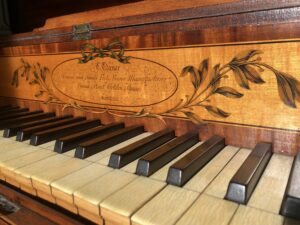Christopher Ganer c. 1785
Description

| Date: | 1785 |
| Origin: | London |
| Serialnumber: | 1070 (?) |
Christopher Ganer was one of the most outstanding piano makers of the late 18th century in London, whose influence on the art of piano making was of great importance. Through his exceptional craftsmanship and innovations, Ganer made a significant contribution to the development of piano making and the cultural landscape of his time. His instruments were valued for their exceptional sound quality, their precision craftsmanship and their aesthetic beauty. For example, he made instruments for Longman & Broderip. His instruments were also very popular on the continent, especially in France. Although Christopher Ganer did not achieve the same notoriety as some of his contemporaries, he still left a significant legacy in the world of piano making. His few surviving instruments are now sought-after collector’s items and are valued by musicians and enthusiasts around the world.

Christopher Ganer, London ca. 1785 – Eric Feller Collection
The case of this delicate and elegant instrument is made of solid mahogany and richly decorated with inlaid decorative ribbons (also at the inside of the lid). It rests on its original trestle stand. The lower keys are covered with ivory and the upper keys with ebony. There are two small decorative notches on each lower key which were coloured with iron gall ink. This detail was very common as a decorative element on harpsichord keys and can be found here as a decorative remnant. It is mainly found on very early instruments.
Inside there are two hand stops on the left side for dampers and lute. The hammers are covered with leather and the instrument is double strung. The action is an English Single Action according to Zumpe.

Christopher Ganer, London ca. 1785 – Eric Feller Collection (Inscription on nameboard)
The nameboard is painted with flowers and garlands and bears the signature in an oval cartouche:
“C. Ganer
Grand and Small Forte Piano Manufacturer
Broad Street, Golden Square
London”
The number 1070 is handwritten on the soundboard. Whether this is the serial number has not yet been clarified with certainty, as Ganer did not usually sign his instruments with a serial number. The square piano originally comes from Birtles Hall in Cheshire and was sold at Sotheby’s in 1994 (catalogue number 137).

Christopher Ganer, London ca. 1785 – Eric Feller Collection (serial number (?) on soundboard)
Christopher Ganer was born in Leipzig around 1750. Like many instrument makers, he left the continent and immigrated to England where he worked as a harpsichord and piano maker from 1774 onwards (as well as a harp maker from around the mid-1780s). At that time, his workshop was at No. 22 Broad Street, Golden Square, later at No. 47 Broad Street. Until around 1784, Ganer always dated his instruments with the Latin inscription “Christopher Ganer Londini Fecit”. In 1774 he married Lydia Willey and had four daughters and a son, who died in infancy. According to different sources, he died in 1811 (in some sources also in 1818).
Principally special about Christopher Ganer’s instruments is that, in addition to the typical “trestle stands“, he also built the “French stands“, which became fashionable from 1777/78. Such an instrument with a “French stand” can also be seen in the Eric Feller Collection. His skills as an excellent cabinetmaker allowed him to build particularly elegant instruments decorated with exquisite inlays. All of his instruments are individually designed and all are different.
Other surviving instruments by Christopher Ganer:
- ca. 1785 square piano (No. ?) – Fondazione Cassa di Risparmio, Bologna Italy
- ca. 1785 square piano (No. ?) – Eric Feller Early Keyboard Instruments Collection, Germany
- ca. 1785 square piano (No. 456) – National Museum of American History, Smithsonian Institution, Washington USA

Christopher Ganer, London ca. 1785 – Eric Feller Collection (5)
| Length: | 160 cm |
| Width: | 82,2 cm |
| Height: | 21 cm |
| Circumference: | 5 octaves (FF – f3) |
| Mechanics: | Single Action after Zumpe |
| Pedals: | 2 hand stops (dampers & lute) |
| Signature: |
"C. Ganer Grand and Small Forte Piano Manufacturer Broad Street, Golden Square London" |

